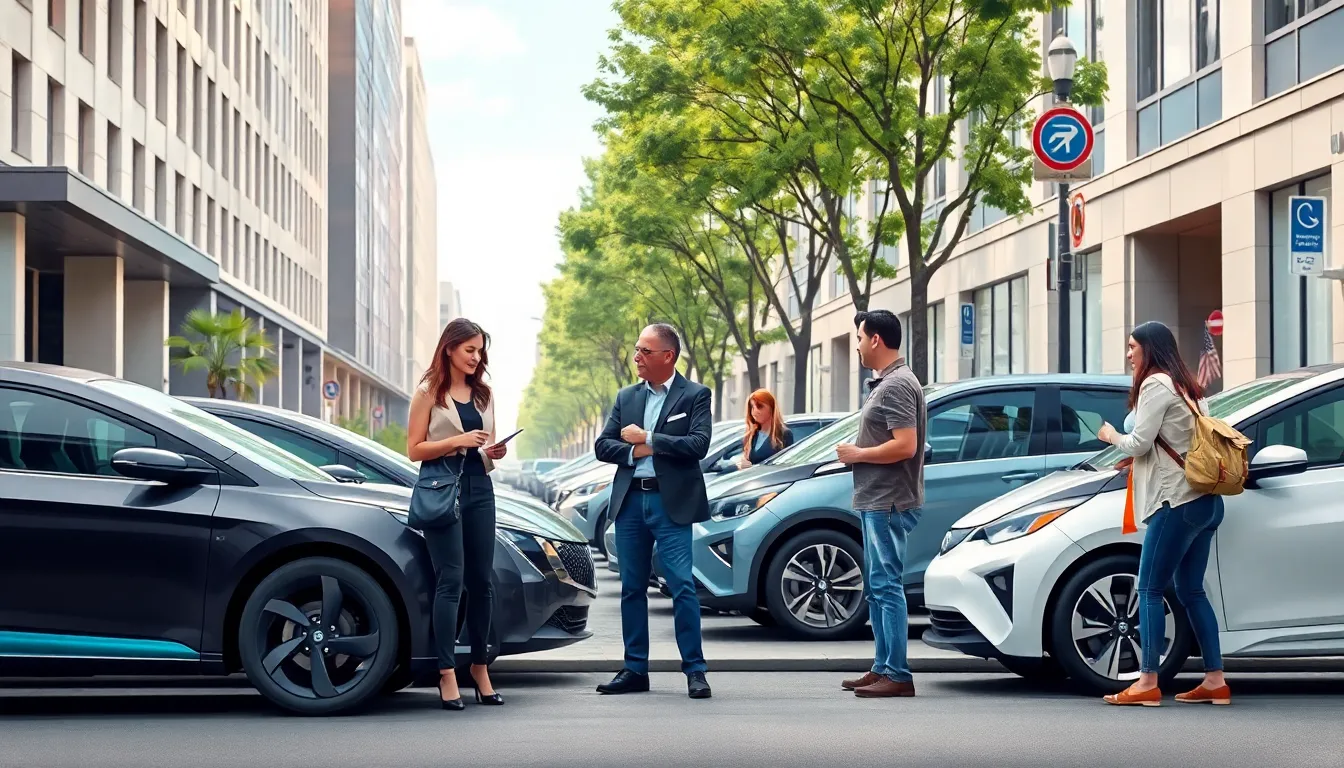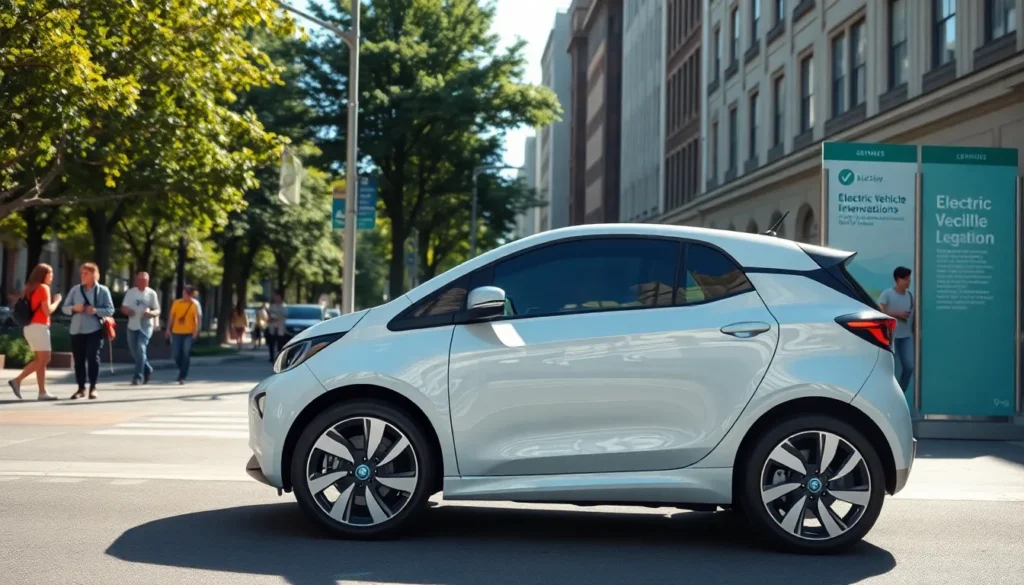Table of Contents
ToggleStreet legal electric vehicles are transforming the way we think about transportation. Imagine cruising around town in a car that’s not only stylish but also quietly humming along with zero emissions. It’s like driving the future, minus the flying cars, because let’s face it, we’re not quite there yet. But what does it really mean for a vehicle to be street legal? How can one ensure they stay on the right side of the law while enjoying all the benefits of electric driving? Buckle up as we explore the exciting world of street legal electric vehicles, the rules that make them legit, and why they might be the next best thing since sliced bread.
Understanding Street Legal Status

To grasp the concept of street legal electric vehicles, it’s essential to understand what ‘street legal’ actually means. A vehicle’s street legal status indicates it meets specific regulations set forth by government entities. These rules typically cover safety standards, emissions, and necessary equipment. Think seat belts, headlights, and brake lights – all the goodies that keep drivers safe and sound.
In the U.S., the definition can vary from state to state. Some states have stringent regulations, while others offer a more relaxed approach, especially for newer technologies like electric vehicles. It’s crucial for prospective buyers to familiarize themselves with local laws to avoid any unwelcome surprises. After all, no one wants to be pulled over for driving what might be considered a high-tech go-kart when they thought they were making an eco-friendly choice.
Types of Street Legal Electric Vehicles
Street legal electric vehicles come in a delightful array of shapes and sizes. Some popular types include:
- Battery Electric Vehicles (BEVs): These are the poster children for electric vehicles. They run solely on electric power and often provide a longer range compared to other types, making them ideal for daily commutes.
- Plug-in Hybrid Electric Vehicles (PHEVs): These offer the benefits of both electric and gasoline engines. This versatility allows drivers to enjoy electric driving for shorter trips while having a gasoline option for longer journeys.
- Neighborhood Electric Vehicles (NEVs): Perfect for zipping around town, these lightweight models are designed for low-speed travel. They’re often seen as an excellent option for short distances in residential areas.
- Electric Motorcycles and Scooters: Who says electric vehicles have to have four wheels? These two-wheeled wonders are increasingly popular among urban commuters looking for a compact, efficient form of transportation.
With such variety, there’s likely a street legal electric vehicle to suit anyone’s needs.
Benefits of Owning a Street Legal Electric Vehicle
There’s a good reason why street legal electric vehicles are gaining traction. Here are a few enticing benefits that make them hard to resist:
- Environmental Impact: One of the standout perks is the reduced emissions. Driving an electric vehicle can slash one’s carbon footprint and contribute to cleaner air. It’s like giving Mother Earth a much-needed hug.
- Cost Savings: Electric vehicles tend to have lower operating costs compared to their gas-guzzling counterparts. Charging often costs less than filling up a gas tank, and maintenance is usually cheaper since electric engines have fewer moving parts.
- Incentives and Rebates: Many states offer tax incentives, rebates, and even grants for electric vehicle buyers. It’s like the government is giving out high-fives for going green.
- Quiet Operation: EVs offer a serene driving experience. No engine noise, just the quiet hum of groundbreaking technology. Plus, that tranquility extends to the cities, reducing noise pollution.
- Innovative Technology: Electric vehicles often come loaded with the latest tech features, from advanced navigation systems to smart connectivity that keeps drivers informed and entertained on the go.
Who wouldn’t want such a well-rounded package?
Regulatory Considerations for Street Legal Electric Vehicles
Navigating the regulatory landscape for street legal electric vehicles can feel a bit intricate. Federal and state rules dictate many aspects of electric vehicle production and operation. Here are some critical points to keep in mind:
- Safety Standards: As with any vehicle, complying with safety regulations is non-negotiable. These include crash tests and safety feature requirements that ensure occupants are protected.
- Licensing and Registration: Just like traditional vehicles, electric vehicles require proper registration and insurance. This helps to ensure accountability and compliance with the law.
- Charging Infrastructure: Some states are ramping up initiatives to develop charging networks that make owning an electric vehicle even more convenient. This infrastructure development is crucial for the widespread adoption of electric vehicles.
- Local Regulations: It’s important to note that local municipalities may have unique requirements or restrictions about where and how electric vehicles can operate. Always check local ordinances before hitting the road.
Keeping these regulations in mind helps potential drivers stay compliant and enjoy the open road without a hitch.
Future Trends in Street Legal Electric Vehicles
The future of street legal electric vehicles looks bright. Here are some trends to watch:
- Autonomous Technology: As we dive deeper into the future, electric vehicles are becoming smarter, too. Many manufacturers are developing self-driving technology, with electric vehicles at the forefront of these innovations.
- Battery Advancements: Battery technology is constantly evolving, leading to longer ranges and shorter charging times. Imagine charging up your vehicle in mere minutes rather than hours.
- Expanded Availability: As more manufacturers enter the electric vehicle marketplace, the range of models and price points will continue to grow, making ownership more accessible to the average consumer.
- Integration with Renewable Energy: Future electric vehicles may use renewable energy sources for charging, further reducing their environmental impact. Solar-powered charging stations are just one example of how this trend is taking shape.
The trajectory of street legal electric vehicles paints an exciting picture, blending sustainability and innovation seamlessly.







